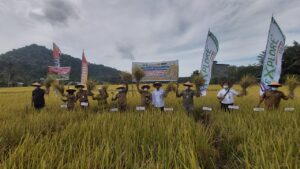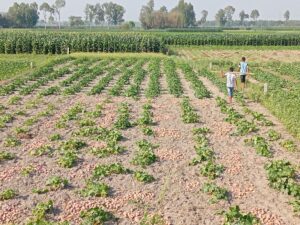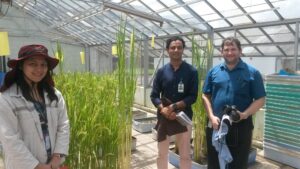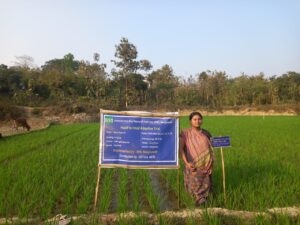Large portions of the fertilizer N applied to flooded rice fields are rapidly lost as gases to the atmosphere. As a general principle, about one-third of the fertilizer N applied by conventional farmers’ practices to irrigated rice grown in paddies (lowland rice) in Asia is lost within two weeks to the atmosphere as gases. About one-third of the fertilizer N remains in the soil at crop harvest, and only about one-third of the fertilizer N is taken up by the rice crop.
Beginning in the 1970s and continuing through the 1980s, research on N management for lowland rice largely focused on increasing N fertilizer use efficiency through “reducing N loss.” The aim was to increase the portion of fertilizer N taken up by the rice crop. A key parameter of success was the “recovery efficiency” or percentage of applied fertilizer N taken up by the mature rice plant.
The recommendations for farmers arising from research in the 1980s and 1990s involved splitting the application of fertilizer N two or three times during the growing season. Rates of fertilizer N were preset and uniform across vast rice-growing areas for a given growing season. The recommended first timing of fertilizer N application was typically before crop establishment (basal), involving use of one-third to two-thirds of the total fertilizer N to be used throughout the season. Thorough incorporation of fertilizer N into soil before rice establishment—preferably without standing floodwater—was promoted as a way to reduce N loss.
Through the 1990s and onward, emphasis was placed on matching the application of fertilizer N to the real-time, field-specific needs of a rice crop. During the past 20 years, the focal message for increasing N fertilizer use efficiency has evolved from “reducing N loss” to “feeding crop needs.” This evolution recognizes the importance of managing N to accommodate the diversity in field-, season-, and variety-specific needs of rice for supplemental N. Varying the application of fertilizer N to “feed” the specific needs of a crop enhances opportunities for increasing yield per unit of applied fertilizer N while also reducing N loss and increasing recovery of fertilizer N by the crop.
During the past 20 years, the key parameter of success has evolved from increased “recovery efficiency” of fertilizer N to increased “agronomic efficiency,” which is the increase in grain yield per unit of fertilizer N applied. This emphasis on the output per unit of input without compromising on the need for high yield acknowledges the importance of ensuring increased profit for farmers. Over the same period, guidelines have evolved from preset and uniform fertilizer rates across vast areas to an increased awareness of the importance of adjusting rates and timings to site-specific and growth stage-specific needs.
Guidelines are now available whereby fertilizer N rates for field-, season-, and variety-specific conditions can be determined from the estimated crop response to fertilizer N and a targeted agronomic efficiency for fertilizer N (see The evolution of nitrogen management, below). The split application of fertilizer N remains an essential component of recommendations.
Monitoring of farmers’ fertilizer practices in Asia in the past decade revealed that farmers often apply a substantial portion of their fertilizer N either before or within two weeks after crop establishment. Their early application of fertilizer N consequently often exceeds the demand of young rice for N. This can lead to vegetative growth in excess of the optimum, which can increase the susceptibility of the crop to lodging (falling over), pests, and diseases.
Recent advances in N management for rice include as a key component the adjustment of the early N application to match the relatively low demand of young rice for supplemental N. Guidelines are now available to ensure appropriate use of only moderate early N to match crop needs.
Another key component of recent advances in N management involves varying rates and distribution of fertilizer N within the growing season to match crop demand for supplemental N. In this respect, the leaf N status of rice, which is closely related to photosynthetic rate and biomass production, serves as a sensitive indicator of the crop demand for N during the growing season.
The leaf color chart (LCC) is an inexpensive and easy-to-use tool for estimating leaf N content. The LCC is usually a plastic, ruler-shaped strip containing four or more panels that range in color from yellowish green to dark green. Several types of LCCs with varying shades of color and varying guidelines for N application have been developed and distributed to rice farmers. Guidelines initially established with LCCs were based on realtime N management in which farmers monitor leaf color at 7- to 10-day intervals about four to six times during the growing season.

Farmers then apply fertilizer N whenever the leaves are more yellowish green than a threshold LCC value, which corresponds to a critical leaf N content. Rice farmers, when presented with options for using the LCC, often prefer less monitoring of leaf color. An alternative fixed-time option widely disseminated since 2004 enables farmers to monitor leaf color only twice: once at active tillering (when shoots emerge from the main stem of the rice plant) and once at panicle initiation (when the grain bunches of the rice plant first form). These are the two growth stages critical for a sufficient supply of N. Farmers then adjust their applications of fertilizer N upward or downward based on leaf color, which reflects the relative need of the crop for N at these stages.
The International Rice Research Institute, through collaboration with partners across Asia, has developed and calibrated a standardized LCC (see photo, above) that enables farmers to select between equally effective real-time and fixed-time N management options for varying within-season N rates. This LCC has been widely distributed and taken up across Asia since 2004. It is to date the only LCC calibrated across large rice-producing areas for both N management options, enabling farmers to opt for less laborious fixed-time N management.










